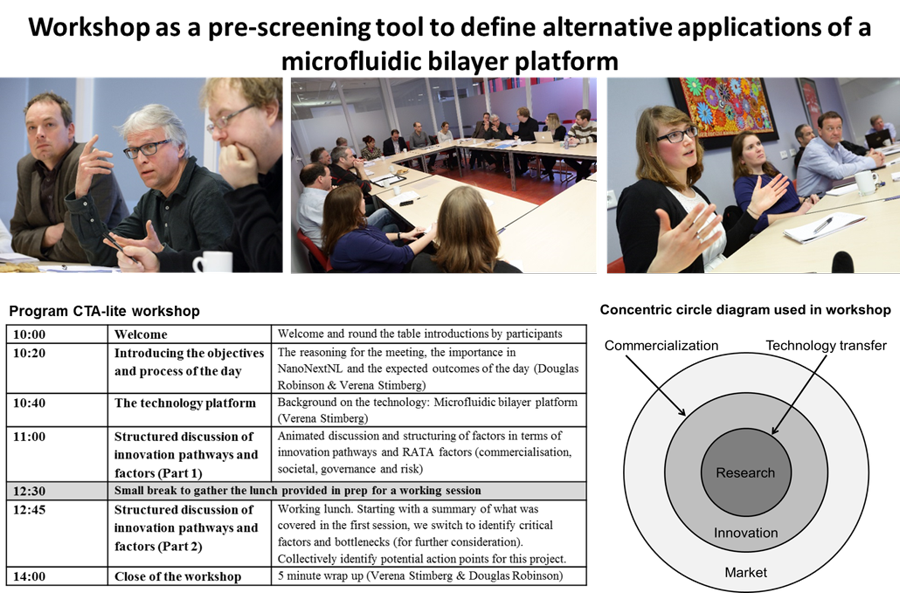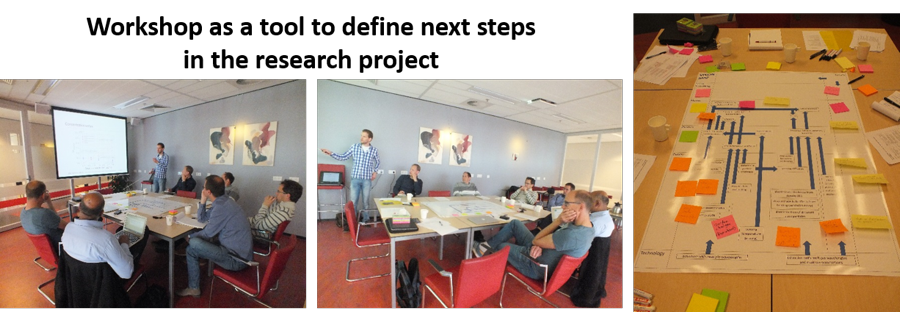Aim
Workshops are gatherings of a group of people to discuss a specific topic. Probably most of you have already attended such an event. In the field of Constructive Technology Assessment (CTA), workshops are organized as bridging event to stimulate the interaction between different groups of people. Specifically, in the technology development process, these people can be different stakeholders such as researchers and technology developers, companies, regulatory agencies or non-governmental organizations that have a certain interest in or concern about the technology. The main goal of these CTA workshops is the learning process of all participants, which is slightly different compared to other types of workshops. Participants are stimulated to acknowledge and understand the views of the other stakeholders and to become aware of ongoing technological and societal developments. Eventually, this learning process could translate into actions and interactions of stakeholders during the technology development process with the aim to increase the societal acceptance of the emerging technology and its societal uptake. Next to the interesting setting of a CTA workshop, it is also a good opportunity to meet potentially interesting collaborators and to broaden the own network.
Practical considerations and implementation
The preparation of a CTA workshop is rather extensive. Often, the workshop is prepared by carrying out interviews with relevant stakeholders to prepare so-called ‘pre-engagement’ activities, for example a multi-path map or a scenario, that are then used during the workshop to stimulate discussion (Huang et al., 2012; te Kulve & Rip, 2011, Robinson & Propp, 2008). A lighter version of such a workshop, the CTA-lite workshop, can be carried out by decreasing the preparation time and including preparatory tools, such as mapping exercises, in the workshop to construct them together with the participants (Schulze Greiving et al., 2016). Additionally, the support of an experienced CTA practitioner is of great value who can help to identify interesting questions and topics for the CTA-lite workshop and who can help to facilitate and moderate the event.
Characteristics | Practical implementation |
|---|---|
Suggested time Long (0.5-1 day workshop + days/weeks preparation time) Level of difficulty Advanced (moderation / facilitator skills required) Materials needed Room with beamer/screen, flip over or white board, post-its, tape, pens, coffee / tea / lunch People involved Researcher (you), CTA practitioner (ideally), workshop attendees |
|
Examples
CTA-lite workshop as a pre-screening tool for a nanomedicine platform
This CTA-lite workshop has been organized by a PhD student with the support of an experienced CTA practitioner (Schulze Greiving et al., 2016; Stimberg, 2014). Here, the workshop has been used as a pre-screening tool to gather information on alternative applications for a microfluidic bilayer platform. Therefore, actors with a broad variety of backgrounds were invited (technical and social scientists, companies, experts in regulations and IP) to enrich the discussion and give insights on different aspects and applications. The invited participants were contacts from the PhD student and her supervisor, as well as from the CTA practitioners.
The workshop started with a short presentation of the PhD student about her technology to provide the participants with background information on the nanomedicine platform. She also introduced a ‘concentric circle diagram’ that represents three stages, from research, innovation and market, defined for the technology development process. The following discussions during the workshop followed the structure of the diagram and were moderated by the CTA practitioner accordingly. In the second part of discussion, a multi-path map is created together with the participants. The workshop made the PhD student aware of broader socio-technical aspects that are relevant for the technology she developed and resulted in additional ideas for future applications.

CTA-lite workshop for a Young interferometer biosensor
In this example, the workshop has been used to define new research questions and the next steps that are required to further develop the Young interferometer investigated in this project [6]. In this workshop, mainly technical researchers a participated and consequently more technical aspects were discussed. A multi-path map has been prepared by the PhD student in advance and was filled in during the workshop together with all participants.

Literature
- Huang, L., et al., 2012, Visualising potential innovation pathways in a workshop setting: the case of nano-enabled biosensors. Technology Analysis & Strategic Management, 24(5): p. 527-542.
- te Kulve, H. and A. Rip, 2011, Constructing Productive Engagement: Pre-engagement Tools for Emerging Technologies. Science and Engineering Ethics, 17(4): p. 699-714.
- Robinson, D.K.R. and T. Propp, 2008, Multi-path mapping for alignment strategies in emerging science and technologies. Technological Forecasting and Social Change, 75(4): p. 517-538.
- Schulze Greiving et al., 2016, ‘CTA-lite’ for exploring possible innovation pathways of a nanomedicine-related platform – embedded Responsible Research and Innovation in practice, In: DM Bowman, A Dijkstra, C Fautz, J Guivant, K Konrad, H van Lente and S Woll (eds), Responsibility and Emerging Technologies: Experiences, Education and Beyond, Berlin: AKA Press, 25-42.
- Stimberg, V., 2014, Microfluidic Platform for Bilayer Experimentation - From a Research Tool towards Drug Screening. PhD thesis, University of Twente: Enschede.
- Mulder, H., 2016, Size-selective analyte detection in an integrated optical Young interferometer biosensor. PhD thesis, University of Twente: Enschede, The Netherlands.
